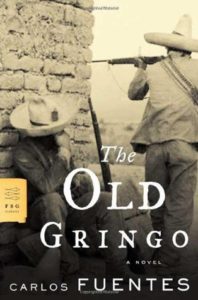 I wish I could say this novel was an enjoyable read but, frankly, this humble reviewer found it rather a chore getting to the end. Since finishing it, curiosity has driven me to go looking to see what other people had to say about it. And it would appear that the verdicts are decidedly mixed. There’s the usual “wonderful”, “engrossing”, “perfect little gemstone”, “an absolute gem of a book”, “a tale of breathtaking astuteness and insight,” etc. etc. But there are also comments such as: “It’s like Fuentes wrote this in his sleep.” or, “…his novel lacks intelligence.” I have to confess I belong with the latter camp.
I wish I could say this novel was an enjoyable read but, frankly, this humble reviewer found it rather a chore getting to the end. Since finishing it, curiosity has driven me to go looking to see what other people had to say about it. And it would appear that the verdicts are decidedly mixed. There’s the usual “wonderful”, “engrossing”, “perfect little gemstone”, “an absolute gem of a book”, “a tale of breathtaking astuteness and insight,” etc. etc. But there are also comments such as: “It’s like Fuentes wrote this in his sleep.” or, “…his novel lacks intelligence.” I have to confess I belong with the latter camp.
The story is based on the mysterious death/disappearance of the American writer Ambrose Bierce who, at age 71, went into Mexico in 1913 during the Revolution and vanished. Bierce is the author of such works as “The Devil’s Dictionary” and “Incident at Owl’s Creek Bridge.” He was a contemporary of writers like Bret Harte and Mark Twain. He was also a newspaper reporter, employed at the time of his death by the San Francisco Chronicle, which was part of the William Randolph Hearst empire. Bierce had also seen distinguished service in the Civil War.
No one knows for sure what actually happened to him. He simply vanished and Carlos Fuentes has used this mystery as the basis for his novel. It’s sounds like a good foundation to build a story on. He’s not trying to explain the mystery but, rather, is simply using the situation as his starting point. I just wish it had worked itself out in a more interesting manner.
Fuentes has chosen to have his Old Gringo cross the border into Mexico with, apparently, a desire to die here. The old man makes reference to this several times in the story with comments like: “Don’t you understand? I want to die. That’s why I came here. To be killed.” And: “You won’t see me again; you may hear of me being stood up against a Mexican stone wall and shot to rags. It beats falling down the cellar stairs.” He meets up with Tomas Arroyo, one of the generals who serves Pancho Villa in his revolution against the prevailing regime. He even fights in Arroyo’s army and draws attention to himself for his bravery. We’re treated here to some interesting battle sequences as the action ensues. The Old Gringo’s bravery however may simply be recklessness motivated by his desire to die. In any event, he meets up with the General and also with an American woman, Harriet Winslow. Ms. Winslow was governess to a wealthy Mexican family. The rebel army has taken over the family’s estate and she is now simply a victim of the revolution. She and Arroyo are attracted to one another.
From then on the narrative seems to slip back and forth among the three characters and to concern itself with differences between Americans and Mexicans and relationships between the three of them.
One of the problems I had with the narrative is that the characters all seem to speak with the same voice and to sound as though they are making speeches. I don’t know if this is because of Fuentes or his translator. This is how a great deal of dialog sounds: “Allotted time!” exclaimed Arroyo, and then laughed. “Let him live just as much as he has lived up until now, let him double his life, gringuita, and you will see how he will hate it. He will hate us if we grant it to him. No, gringa, we die because our paths cross. The desert is big. Graciano, don Graciano, was buried in it. He always lived there. His forefathers came to see him being laid in the ground. The old gringo came here. No one asked him. He has no forebears here. It would be a lonely death. No one would visit his grave. It would have no name. Tell him to go away quick, gringa. He is not one of us….” And on and on. And there’s so much slipping back and forth between the characters I wasn’t always sure who was speaking or thinking.
Stylistically I also had trouble with several over-long sentences. A couple of them were so long they stopped me dead in my tracks so that I could count the number of words. Each one consisted of more than 230 words. That’s almost a page of type in this book. There were several other passages where I stopped and had to read and re-read to figure out the meaning of what was being said. Frankly, I would say that if a reader grinds to a halt to try to figure out who’s talking or what they started out saying then it’s time to take another look at the writing and editing. When the readers start counting the words in some of the sentences that’s a huge warning sign.
Enough already!
In my humble O: Obviously I wasn’t impressed.

The Old Gringo
By Carlos Fuentes
Translated by Margaret Sayers Peden, 1985
Available from Amazon Books: Paperback
